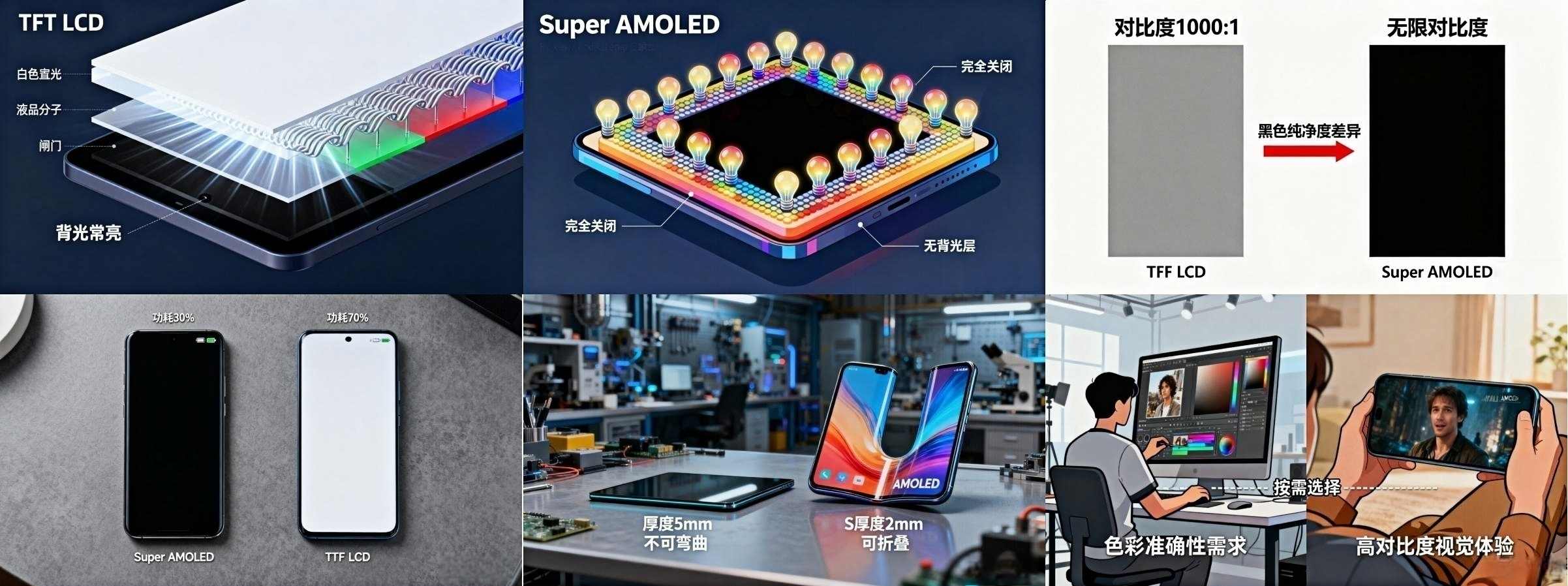When you’re choosing a smartphone, smartwatch, or any modern device, the display is your primary window to the digital world. Two dominant technologies power most of these screens: TFT LCD そして スーパーAMOLED.
But what exactly sets them apart? Is one objectively better? This comprehensive guide dives deep into the science and performance of TFT LCD and Super AMOLED displays, helping you make an informed decision based on your needs.
Understanding the Core Technology
The fundamental difference lies in how these screens produce light and color.
What is TFT LCD?
TFT LCD (Thin-Film-Transistor Liquid Crystal Display) is a type of “透過性の” display. Think of it as a sophisticated light filter. Here’s how it works:
A backlight layer (usually LEDs) shines white light uniformly across the entire screen.
This light passes through a liquid crystal layer. Each pixel is controlled by a tiny transistor (TFT) that twists the liquid crystals to act as shutters, regulating how much light passes through.
The filtered light then hits a color filter sub-pixel (red, green, and blue) to create the final color you see.
Key Takeaway: Since the backlight is always on, displaying black simply means the liquid crystals try to block the light, resulting in a dark gray rather than true black.
What is Super AMOLED?
スーパーAMOLED (Active-Matrix Organic Light-Emitting Diode) is Samsung’s branded term for an advanced “emissive” display. In this technology:
Each individual pixel is composed of tiny organic light-emitting diodes that produce their own light.
When an electric current is applied, the sub-pixels (red, green, blue) illuminate directly.
To display black, the pixels simply turn off completely, consuming no power for that area.
Key Takeaway: The absence of a separate backlight and color filter layer is the source of Super AMOLED’s key advantages.
Head-to-Head: TFT液晶 vs. スーパーAMOLED
Let’s break down their performance across critical categories.
1. Contrast Ratio and Black Levels
TFT LCD: Struggles with true black because the backlight remains active. This results in a lower contrast ratio, making blacks look washed out or grayish, especially in a dark room.
スーパーAMOLED: The clear winner. With the ability to turn off individual pixels, it achieves an essentially infinite contrast ratio and perfectly deep, inky blacks.
Winner: スーパーAMOLED
2. Power Consumption and Battery Life
TFT LCD: Power draw is relatively constant, as the backlight is always on at a fixed brightness. The overall consumption depends on how much of the backlight is blocked.
スーパーAMOLED: Power efficiency is content-dependent. It excels when displaying mostly black or dark themes, as those pixels are off. しかし, a full white screen can be more power-hungry than a comparable LCD.
Winner: スーパーAMOLED (for typical mixed use and dark mode users)
3. Color Reproduction
TFT LCD: Traditionally offers more color-accurate and natural-looking images, especially on high-quality IPS panels. This makes it a preferred choice for tasks like photo editing where color fidelity is critical.
スーパーAMOLED: Known for its vibrant, oversaturated, and punchy colors that “pop.” While visually striking, purists may find it less accurate out of the box (though color calibration modes can help).
Winner: Tie (Depends on user preference for accuracy vs. vibrancy)
4. Thickness and Flexibility
TFT LCD: The multi-layer structure, including the backlight, makes it inherently thicker and more rigid.
スーパーAMOLED: With fewer layers, it is significantly thinner and inherently flexible. This is why it’s the technology behind curved edges, foldable phones, and rollable screens.
Winner: スーパーAMOLED
5. Sunlight Visibility and Brightness
TFT LCD: Performance is tied directly to backlight strength. In bright sunlight, it can struggle with glare and reflections, making it harder to see.
スーパーAMOLED: Modern Super AMOLED panels can achieve very high peak brightness levels. Combined with their anti-reflective coatings, they generally offer superior visibility in direct sunlight.
Winner: スーパーAMOLED
6. Lifespan and Screen Burn-In
TFT LCD: Very stable and long-lasting technology. The backlight may dim over thousands of hours, but it is virtually immune to permanent image retention or “burn-in.”
スーパーAMOLED: The organic materials degrade over time. The blue sub-pixel degrades fastest, leading to potential color shifts. If a static image (like a status bar) is left on for too long, it can cause permanent burn-in.
Winner: TFT LCD
7. Cost and Eye Comfort
TFT LCD: A mature, cost-effective technology, making it a go-to choice for budget and mid-range devices. Many LCDs use DC dimming, which is less likely to cause eye strain for sensitive users.
スーパーAMOLED: More expensive to manufacture. Many AMOLED screens use PWM (Pulse-Width Modulation) dimming at low brightness levels, which can cause eye fatigue or headaches for some individuals.
Winner: TFT LCD
The Verdict: Which One Should You Choose?
The choice isn’t about which is universally better, but which is better for you.
Choose Super AMOLED if you:
Prioritize deep blacks and a cinematic viewing experience for HDR content.
Love vibrant, saturated colors.
Want a thinner device or a curved/foldable screen.
Use dark mode extensively to save battery.
Need the best possible visibility in sunlight.
Choose TFT LCD if you:
Require color accuracy for professional work like graphic design.
Want a more budget-friendly option without major compromises.
Are concerned about long-term screen burn-in.
Experience eye strain from PWM dimming and prefer a flicker-free experience.
Ultimately, both technologies have their merits. Super AMOLED offers a premium, high-contrast visual feast, while TFT LCD provides a reliable, accurate, and cost-effective solution. By understanding their core differences, you can confidently select the display that best fits your lifestyle and priorities.
Looking for high-quality displays for your products? We supply a wide range of TFT LCD and AMOLED screens for various applications. Contact us today to find the perfect display solution!


